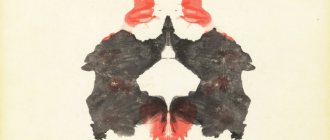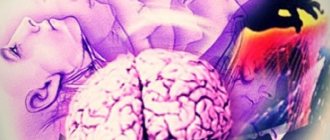Test is a synonym for "cup" and comes from Old French. The vessels made of baked clay that alchemists used for their experiments were called “tests”.
In Russian this word had two meanings:
- A religious oath, a probationary oath taken by a person entering into public office, thereby proving that he is not a secret Catholic;
- The second meaning is a flat smelting vessel that was used to separate tin from gold or silver.
As a psychological term, “test” appeared at the end of the 19th century. The term test is used along with the term methodology, and in the 1970s, when Soviet psychodiagnostics was being established, the term had a negative meaning, denoting its “bourgeois origin.” At that time, all tests were renamed methods. In our time, there is no reason to abandon this term-concept, with which the entire history of psychodiagnostics is connected.
It is quite clear that, like any cognitive tool, the test has its own characteristics. Depending on the specific circumstances of the study, the features of the tests can be considered as its advantages or disadvantages.
The effectiveness of using tests will depend on taking into account many factors:
- The theoretical concept that is the basis of a particular test;
- Scope of its application;
- A set of information determined by standard requirements for psychological tests and psychometric characteristics.
It must be said that the well-known ideas about the “simplicity” and accessibility of tests do not correspond to reality at all. The test, being a means of studying the most complex mental phenomena, cannot be interpreted simplistically as a proposal of a task and registration of its solution. Only if one relies on general psychological knowledge, competence in the theory and practice of relevant research, is the scientific use of tests possible. In addition, it is important to follow the ethical standards of psychodiagnostics.
Thus, a psychological test is a standardized task. Its results speak about the psychophysiological and personal characteristics, knowledge, skills and abilities of the subject. Psychological tests have their own areas of application:
- Diagnosis of mental states and personality traits;
- Diagnosis of interpersonal and family relationships;
- Diagnostics of professional personnel selection.
Intelligence tests
This group of techniques allows you to assess the quality and speed of cognitive processes occurring in your brain: memory, perception, attention, thinking. The better the results, the more effective any of your activities. However, you should not take them as a constant. All brain functions can be trained. Low readings today could become very high readings in a month.
Take the tests and mark the functions you would like to improve, and start studying hard. After a while, repeat the diagnostics and record the results.
- Eysenck IQ test
A classic technique used to measure IQ. Contrary to popular belief, it does not determine the quality of knowledge and erudition, but records a person’s ability to find patterns, see logical connections, operate with abstract concepts, etc. You will be asked to answer 40 questions in 30 minutes.
- Raven's Progressive Matrices
Another test aimed at assessing intellectual development. Unlike the previous one, all tasks here are of the same type and simple. The subject is presented with images with missing fragments and 5-6 variants of these same fragments. You need to choose the right one.
- Logical thinking test
An interesting and fun technique that evaluates your ability to think logically. Strange statements will appear on the screen. For example: “Some apples are dogs. All dogs are one-eyed.” Below them you will find several logical conclusions from which you need to choose the correct ones. A total of 12 such tasks await you. They need to be completed in 8 minutes.
- Bennett's Engineering Thinking Test
It is also called a technical understanding test. Helps identify people with an engineering mindset. 70 questions await you about gears, cogwheels, weights, etc. Most of them require you to calculate the trajectory of movement. The passage takes 30 minutes.
- Testing memory using the “Image – Number” system
This technique not only measures your memory skills, but also trains them. Pictures with numbers will appear on the screen, your task is to remember which picture corresponds to which number.
- Hall Emotional Intelligence Test
Emotional intelligence helps us navigate our own and others' emotions. It underlies most metaskills, without which a productive and successful life is impossible today.
The test helps assess emotional intelligence using 5 parameters: emotional awareness, emotion management, self-motivation, empathy, and influence on the emotions of other people. It consists of 30 statements with which you need to agree or disagree.
This is by no means the only technique. The rest can be found in our expanded selection of emotional intelligence tests.
More than 100 cool lessons, tests and exercises for brain development
Start developing
- Cognitive ability test
A technique on the Vikium platform will help you evaluate the performance of all cognitive functions at once. Based on the results of completion, you will receive a detailed description of your cognitive profile, including such characteristics as the level of concentration, visual and figurative thinking, short-term and long-term memory, verbal and non-verbal logic.
You will also learn some personal characteristics that affect your performance and efficiency, your strengths and weaknesses. The test is paid and costs 990 rubles. It will take about half an hour to complete.
Characteristics of psychological tests
The tests used in our time, both in scientific research and in practical consulting, are very diverse. Despite this diversity, they are subject to the same requirements or, in other words, psychological tests have basic characteristics - validity, reliability, standardization. Let's look at these characteristics:
- Standard. Any test method must undergo standardization; as a result, the data obtained must correspond to the law of normal distribution or a sociocultural norm. In accordance with these norms, ranges of values are formed that indicate the strength of expression of the characteristic being studied;
- The second characteristic of tests is their reliability or the ability of a test to give similar results when repeated measurements. If the technique is reliable, it should give similar results, regardless of the gender of the experimenter or the time of year. The technique itself must minimize all background factors, which determines its reliability;
- Such a characteristic as validity shows the correspondence of the test results to the characteristic for which it is intended. Validity can be internal or external. External validity can be tested by positive correlations with objective achievement, and intelligence test scores can be correlated with academic performance. Internal validity is much more difficult. In this case, we are talking about a theoretical connection - how realistically the internal model models the stated aspect. If there are similar “proven” methods, it is already easier, because it is possible to get by with correlation with an already known method. Internal validity is found through long experimental and intellectual work.
Psychological testing is now used in various areas of social practice. Success or failure in specific situations is determined by the intellectual, emotional, and personal characteristics of a person. Psychological procedures in the form of tests make it possible to quickly and fairly accurately determine what qualities a particular person has. Information obtained in this way allows one to understand much of what happened in his life, predict probable future achievements and successfully overcome many obstacles on the way to a personal goal.
Tests to determine individual characteristics
We are all different. Each with its own characteristics, advantages and disadvantages. Some people love silence and solitude, but for others it’s a punishment. Some people prefer to move towards their goal in small but regular steps, while others rush towards it with all their might. And that's certainly a good thing.
It is desirable for a person to know his own characteristics. In this case, he will be able to take them into account when planning activities and predicting results. Some of these characteristics are innate and beyond our control. But there are also those that can be successfully adjusted.
- Eysenck temperament test
Perhaps the most common typology in psychology is the division into temperaments. This is the foundation on which other psychological classifications rest. Temperaments were first identified by Aristotle, correlating the totality of human traits with the predominant fluid in the body.
Today it is known that temperament reflects the properties of the nervous system and, accordingly, is an innate and unchangeable characteristic. After passing the test, you will find out who you are: sanguine, choleric, phlegmatic or melancholic. The technique is a questionnaire of 48 questions.
Share in the comments what your temperament is. Let's see which of the 4 types is greater. I'll start with myself: I'm melancholic.
- MMPI personality profile test
If you have a strong interest in yourself and a few hours of free time, I recommend that you take this test. It will help you create the most accurate and detailed portrait of your personality, including such indicators as leading needs, motivational orientation, defense mechanisms, the presence of sexual problems, a tendency to alcoholism and others. There are 566 questions in total that must be answered “yes”, “no” or “I don’t know”.
- Psychological age test
The closer your psychological age is to your biological age, the more adequate and better adapted to reality you are. Too young a psychological age may indicate immaturity, while too high a psychological age may indicate dissatisfaction with life.
Check out our selection of psychological age tests. In it you will find a detailed description of the methods and several options to choose from.
- Perception type test
This test will help you determine your leading representational system. We all perceive the world through 5 senses, but different senses predominate in different people. You've probably heard about visual, auditory and kinesthetic learners. The first concentrate on visual images, the second pay more attention to sound stimuli, and the third - tactile. The technique will help you determine which of them you belong to.
- Self-esteem test
Self-esteem is a very important component of personality. A person’s success in life and subjective feeling of happiness directly depend on it. The technique will help determine how adequate your self-esteem is. You have to answer 32 questions, most of which are based on self-analysis. Remember: the reliability of the results depends on your sincerity.
- Maslow's test for measuring current needs
The test is aimed at assessing the relevance for the subject of basic needs: physiological, safety needs, communication needs, recognition needs, self-actualization needs. The famous pyramid of A. Maslow is taken as a basis.
- Luscher color test
A very interesting and surprisingly accurate test. It allows you to assess several parameters at once: general emotional background, self-esteem, level of excitability, expectations of others, sources of anxiety and much more. The main advantage of the technique is that it is projective, i.e. the subject cannot know how his answer will affect the results. Answers come from the unconscious, bypassing the filters of consciousness. In each question you have to choose the most or least attractive color from the given ones.
The Luscher test is one of my favorites. He helped me face the internal problems that I had long and stubbornly denied.
Groups of projective techniques.
First identified by Frank.
I. Constitutive techniques (structuring techniques).
Presentation of jumbled, unstructured material. The subject needs to give it a subjective meaning, something needs to be seen in it.
For example:
- Rorschach inkblot technique.
- 3D apperception test (not used here)
Created by the Americans in 1947. Stimulus material - 28 standard three-dimensional objects of different shapes.
Two stages of examination:
- from all of them, choose those that he would like to use to compose a story. Objects are selected by touch.
- the subject focuses on kinesthetic internal sensations, tactile sensations.
II. Constructive techniques (construction techniques).
- They require you to create a meaningful whole from certain details, to assemble something, which is carried out in accordance with your own experience, taste, and personal characteristics.
- Using individual fragments of the story, create the entire story. Example: in 1939 - the Peace test (Lovenfeid). Stimulus material: 232 models of different objects, which are distributed into 15 categories (animals, people...). The models are small, made of wood or metal, and have bright colors. The subject must create his own small world (no time limit).
The following evaluation criteria are used:
- number of people
- number of categories
- which models were chosen first
- the occupied space is assessed, the shape of the structure is taken into account
- Observation of the subject's activities provides more information.
Depending on the approaches (practical, aesthetic, logical...) the type of personality and its orientation are assessed.
Make a picture-story (in 1947 Shneidman).
Stimulus material: 21 tables depicting a background (bedroom, landscape, living room) and 67 figures corresponding to the background.
The background pictures are presented one at a time, the subject must select the corresponding figures, arrange them and tell a story about the situation he created.
III. Interpretive techniques
You need to interpret something: situations, stories.
- TAT - thematic apperception test
- Rosenzweig's drawing frustration technique
- Szondi's technique (1939), 48 standard cards with portraits of mentally ill people for 8 diseases:
- sadism
- epilepsy
- hysteria
- catatonia
- schizophrenia
- depression
- mania
- homosexuality
They are divided into 6 series, each time 8 portraits, one for the disease.
You have to choose two of your favorites and two of your least favorites (each series was repeated 6 times).
If 4 or more portraits with one disease are selected, then this diagnostic area is significant for the subject.
The choice of portraits was determined by the needs of the subject; the lack of choice was determined by the satisfaction of the needs.
Negative choices - suppressed, repressed needs; positive choices are recognized needs.
Genetic determinism is the existence of the generic unconscious.
IV. Catactic techniques
Carrying out gaming activities in specially organized conditions.
Example: psychodrama. Developed by Jacob Moreno in 1946. In the form of an impromptu theatrical performance, in which specially trained individuals participate - auxiliary “I”, who create special stimulus conditions.
Certain situations are played out, if they are consonant with the experiences of the subject, then the process of projection of his personality occurs and, as a result of play catharsis, a therapeutic effect occurs.
Catharsis is an effective response.
Doll test technique (we do not use it).
Woltman, Gaworth - 50s of the 20th century. Intended for children under 10 years old, stimulus material - dolls.
Play out with dolls various scenes in which he participates in society (rivalry with brothers, sisters...)
V. Expressive techniques.
Drawing on a free or given topic.
“House-tree-man”, “Non-existent animal”, “Kinetic drawing of a family”.
The myokinetic method of Mir and Lopez - in 1940, consists of 7 subtests, each using a table where lines of different configurations are drawn. Parallels, circles, stairs, chains, zigzags...
You need to trace the lines with a pencil several times, then do the same work blindly with your right and left hands. First in the horizontal plane, then in the vertical.
The main indicators evaluate the length of the line and the nature of their deviation (when tracing blindly).
The interpretation is based on the fact that any mental manifestation is associated with muscle movement.
The dominant half of the body is more developed and is more controlled by consciousness. Motor manifestations of the dominant half of the body reveal the current attitudes of a person. The opposite half of the body is associated with instinctive attitudes.
Depending on the type of deviation, the conclusion about the manifestations of a person’s attitudes. If the deviation is upward, there is a high degree of excitation, etc.
VI. Impressive techniques.
Preference for some stimuli that are more desirable than others.
Luscher color technique (created in 1948), stimulus material - cut out squares of a certain size in different colors. A total of 73 squares, 25 different colors and shades (usually incomplete - 8 squares, 4 primary colors: blue, green, red and yellow; 4 additional colors: purple, brown, black and gray).
All 8 squares are laid out on a white background; you need to choose the most pleasant square in color in relation to the remaining ones.
A series of squares are formed according to the degree of attractiveness.
The first 2 colors are clearly preferred, 3 and 4 colors are also preferred, 5 and 6 are neutral colors, 7 and 8 are colors that cause antipathy.
The interpretation is based on the symbolism of colors: red - the desire for power, green - perseverance, stubbornness. The first 2 choices determine the goals and methods of achieving them for the subject, the last 2 - suppressed needs.
For practical purposes it is extremely rarely used, since the mental state of the subject is diagnosed.
The shades of colors are extremely important.
VII. Additive techniques.
Techniques for completing sentences, stories, stories. Examples: used to diagnose the values, attitudes, anxiety, fears, motives of the subject.
Social Skills Tests
A person’s success in all areas and happiness in interpersonal relationships directly depends on the ability to effectively interact with people. The following techniques will help you objectively assess your communication skills and empathy level.
- Leary Interpersonal Relationships Test
The test is aimed at identifying patterns of behavior inherent in a person in interpersonal relationships. It evaluates a person’s characteristics on two scales: “dominance - submission” and “friendliness - hostility”. Based on a combination of these characteristics, the subject is assigned to one of 8 categories. There are 128 questions waiting for you that you need to answer “yes” or “no”.
- Assessment of the level of sociability of V. F. Ryakhovsky
The technique measures the level of communication skills. You will find out how easy and comfortable it is for you to interact with other people, and whether there are any serious problems in this area. There are only 16 questions, so completion will take no more than 5 minutes.
- Communication Skills Test
If you want to get more detailed characteristics of your communication skills, I suggest using the extended questionnaire. It is often used when hiring to assess a person’s ability to work in a team. The test consists of 100 questions that allow you to diagnose 9 personal characteristics that affect the quality of communication.
- Emotional Empathy Questionnaire
Empathy allows us to correctly interpret the emotions and feelings of other people, empathize with them, and predict their states and desires. A person with a high level of empathy gains a serious competitive advantage. The questionnaire will help you assess your level of empathy and start working on it if necessary.
- Thomas Conflict Behavior Test
People react differently to conflict situations. American psychologist Kenneth Thomas identified 5 main models of behavior in conflicts: competition, adaptation, compromise, avoidance, cooperation. Some of them are productive and some are not. The technique will help you identify your dominant model and, if necessary, adjust it.
Projective methods.
Projective methods are a group of specific techniques aimed at measuring personality. These techniques are aimed at revealing the content of the inner world of the individual.
Specific features of the methods.
Carl Jung was the first to discover the phenomenon underlying projective techniques. It is possible, through indirect influence on significant areas of the subject’s experience, to cause changes in experimental activity.
When doing something, any person shows his attitude towards it. His statements, perceptions, motor acts are a projection of his personality.
The term "projection" was first used by Lawrence Frank to refer to a group of techniques in 1939.
He described the basic principles of projective diagnostics.
In 1896, Freud introduced the term “projection” - attributing to other people socially unacceptable drives and desires that a person denies himself.
At the beginning of the 20th century, Freud uses “projection” in a different sense - a symbolic transfer to the outside - of a person’s inner world. Observing the process of exteriorization of anxiety and fear.
Projection then began to be understood as a normal natural mental process involved in the perception of a healthy person.
Tests for borderline disorders and mental disorders
Special diagnostic techniques will help you track psychological distress and developing deviations. Their results should not be taken as diagnoses, much less self-medicate. If any indicator worries you, contact a specialist. Don't forget to report the tests you took and the results you received.
- Spielberger-Hanin Anxiety Test
Using this technique, you can diagnose both situational anxiety and personal anxiety, which is a fairly stable characteristic. High rates indicate a tendency to perceive many objectively harmless phenomena as threatening. An increased level of anxiety has a negative impact on mental state and quality of life, so it is necessary to work to bring it back to normal.
- Beck Depression Inventory
If you suffer from mood swings, loss of energy and apathy, be sure to take this test. It will help identify depression even in the early stages and determine its severity. The questionnaire consists of statements from which you need to choose those that apply to you.
For a more serious diagnosis, take a look at our selection of depression tests.
- Express diagnosis of neurosis
Neurosis is a mental disorder that is characterized by overexcitation of the nervous system, decreased performance, obsessive states and excessive anxiety. It is extremely difficult to treat in an advanced stage, but can be successfully corrected at the very beginning of the disease. Therefore, it is important not to miss this moment and contact a specialist in time.
- Test for schizophrenia
Schizophrenia is a serious mental illness that makes it difficult for a person to exist in society and often requires isolation. It is very difficult to detect it yourself, since the adequacy of perception is impaired. Using the test, you can check for symptoms of schizophrenia in loved ones by asking them 53 questions from a questionnaire.
- Chronic fatigue syndrome test
Chronic fatigue syndrome is not a mental disorder, but it may well be its cause. The nervous system is very quickly depleted under overload and malfunctions. Check with the help of this technique whether it’s time for you to seriously think about rest.
- Bassa-Darka Aggression Index
Increased aggressiveness is often a consequence of unresolved internal conflicts. If you don't do anything about it, sooner or later it can lead to affect and become the cause of destructive behavior. The test helps determine the level of aggressiveness. You have to agree or refute the presented statements, of which there are 30 in total.
- Szondi test for identifying psychological abnormalities
Let's summarize our sad selection with an interesting psychoanalytic test. It helps to identify character accentuations, that is, strongly expressed, pointed characteristics, which often become the basis for the development of all kinds of deviations. The technique is projective. You won't have to answer the questions directly. Subjects are shown a series of black and white portraits of people. You need to choose 2 most pleasant and 2 most unpleasant portraits.
Ammon Self-Structure Test, 220 questions
German psychiatrist and psychoanalyst Gunther Ammon is one of the creators and leaders of dynamic psychiatry. His test reveals many details about personality, classifying each of the characteristics into three types. For example, Ammon distinguishes the following types of aggression:
- constructive - purposeful activity, the ability to maintain relationships and solve problems in a strong-willed way, actively build one’s own life,
- destructive - misdirected, destructive for oneself and others, breaking relationships, devaluing others,
- deficient - withdrawal into oneself, lack of activity, indifference, avoidance of competition and constructive argument, spiritual emptiness (according to Ammon, this is also aggression).
Anxiety or fear, while remaining within constructive limits, helps to adequately perceive the situation and realistically assess the danger. Destructive fear overwhelms the psyche and paralyzes. Deficient - indicates that the protective function of the psyche and the regulation of behavior no longer serve the patient well.
Gunther Ammon also distinguishes constructive narcissism (adequate positive attitude towards oneself, recognition of one’s weaknesses), destructive (unrealistically high self-esteem, inability to accept criticism) and deficit narcissism (lack of contact with oneself, being a leader, dependence on the opinions of others, abandonment of one’s own interests and needs ).
Tests for children and teenagers
In this category I have collected the most interesting and useful techniques for the younger generation. Teenagers can go through them on their own, small children - with the help of their parents.
- Test “House, tree, person”
The projective technique is very popular among psychologists. With its help, you can conduct a deep analysis of the subject’s personality. Suitable for any age, but especially often used for testing children. The subject is asked to draw a house, a tree and a person on an A4 sheet of paper. After this, you need to answer 158 questions about the finished drawing.
- Honey-Mumford Preferred Learning Style Test
The technique will help identify the most effective ways of learning for your child. The speed and quality of learning the material depends on the correct approach to choosing a teaching style. It is advisable that the child take it before entering school. This will give you the opportunity to help him adapt faster.
- Diagnosis of mental stress and neurotic tendencies in children and adolescents
Parents need to take this test. It contains 45 questions regarding the child’s behavior and well-being, which must be answered “yes” or “no.” It allows you to assess the severity of disorders such as autonomic dysfunction, disturbances of appetite, sleep and behavior, depressive and asthenic disorders, phobias and fears.
- Test for schoolchildren on interpersonal relationships
The technique helps determine the attitude of children aged 10–16 years towards themselves and other people. It is very important that a child at this age develops the ability to accept not only human advantages, but also shortcomings, and to show tolerance for other people’s weaknesses and mistakes. This is the key to effective interpersonal interaction.
- Career Guidance Test
Closer to finishing school, the child begins to think about choosing a profession. This choice is very difficult and important. To make work enjoyable and as successful as possible, you need to take into account individual characteristics. This is why the methodology was created. It helps to determine what a person is best able to interact with in the process of activity: with people, nature, technology, sign systems or artistic images.
Questionnaires.
Questionnaires are a type of methodology in which tasks are given in the form of questions or statements. To obtain information from the words of the subject himself.
Features of using questionnaires.
- Questionnaires are similar to projective techniques, since answers are not assessed based on the criterion of correctness. Points are awarded for matching the key, not for correctness.
- Questionnaires are similar to tests: clear instructions that determine how to complete the task, preferably clear content of questions or statements.
- Questionnaires are a type of self-observation, indirect self-assessment.
Questionnaires are designed to obtain information about personal characteristics from the words of the subject.
To answer is to demonstrate the ability of reflection, introspection, and introspection, which not all people possess.
Questionnaires are not used to diagnose young children of preschool age, only from 8 years old.
Stand out:
- questionnaires - to obtain information about the subject that is not of a personal nature (biographical data, to assess the characteristics of the cognitive sphere).
- personality questionnaires - provide information about the individual:
- typological, which make it possible to find out the degree to which the subject’s personality coincides with one or another personality type.
- questionnaires of individual personality traits - for diagnosing individual character traits: multifactorial (about many traits), for example Cattell (14-, 12-, 16-factor)
- single-factor
- two-factor
In the 50s, the possibility of using personality questionnaires was denied.
In the 60s they began to use it.
By the 60-70s, well-known foreign questionnaires began to be translated (used without checking reliability).
80s - testing for reliability and validity on our subjects.
80-90s - the appearance of domestic questionnaires in large numbers.
Test requirements
- The test must indicate the theoretical basis or the name of the author;
- Must be tested on a specific group of subjects;
- Standards must be specified and who the standard is for;
- There should be a note indicating whether the test requires professional use or can be used by non-professionals;
- Must meet the following criteria:
- Standardization (conditions, contingent, rules for processing results, interpretation);
- Reliability (obtaining the same results when repeated);
- Validity (the ability of a test to measure exactly what it is intended to measure).










